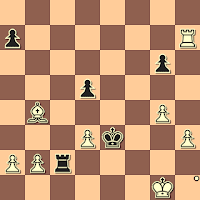I receive many Jerome Gambit (1.e4 e5 2.Nf3 Nc6 3.Bc4 Bc5 4.Bxf7+) games from generous readers of this blog, mostly via email.
Sometimes the email contains a link to the chess website where the game was played, so I can go there and obtain a pgn file of it. Sometimes the email contains the pgn file itself.
Occasionally, the reader includes the raw moves of the games. A few times, I have received videos of the game - and I have been able to watch them, and write down the moves myself.
All of these contributions help build The Database, my collection of over 62,700 Jerome Gambit and related games. (For example, there are almost 15,500 games with the original move order; over 2,700 games with the Italian Four Knights Jerome Gambit; about 6,450 games with the Blackburn Shilling Jerome Gambit; and that's just a sample.)
A while back I received an email with a game's moves and the names of the players. One move was ambiguous, and I wrote the reader a couple of times for clarification, as the game was quite interesting, either way. Alas, I have not heard back. I would like to present the game, anyhow.
Anonymous - Anonymous
2020
1.e4 e5 2.Nf3 Nc6 3.Bc4 Bc5
Here is the confusion, already. The move, as sent, was "3...b5".
I am not sure what to make of the game, if that is not a transcription error. On the one hand, White can simply play 4.Bxb5, winning a pawn in an odd Ruy Lopez. I actually found 15 games with 3...b5, and White scored 13 - 1 - 1 - not exactly a result that calls for an improvement in the line.
On the other hand, the Jerome Gambit has a way of upsetting everything, so it's not impossible that the reader played a novelty, 4.Bxf7+, and saw the game continue 4...Kxf7 5.Nxe5+ Nxe5 6.Qh5+ g6 7.Qxe5 Qe8
Here, White can capture a Rook, with advantage - 8.Qd5+ followed by 9.Qxa8.
However, the game continued with the capture of the other Rook, 8.Qxh8 - and Black resigned, unaware that he had the brutal 8...Qxe4+, similar to the counter in Whistler's Defense. One line would be 9.Kf1 Bg7 10.Qxh7 Qxc3 11.Nc3 b4 and White is going to lose more material.
That is interesting, in and of itself, but what if Black had actually played 3...Bc5 ?
4.Bxf7+
4...Kxf7 5.Nxe5+ Nxe5 6.Qh5+ g6 7.Qxe5 Qe8
Moving Black's Queen to the e-file is similar to the idea behind Whistler's Defense, although in that line, 7...Qe7, the Bishop is defended.
White should now pick up the Bishop, with an edge, after 8.Qxc5 Qxd4+ 9.Kf1. Instead, he went after the Knight.
8.Qxh8 Black resigned
Instead, with 8...Qxe4+, Black could have transposed into Whistler's Defense, with a clear advantage. Once recent example can be seen in "Jerome Gambit: Scared Silly"
So, whichever way the game actually went, Black wound up with a significant advantage, but he resigned, anyway. How very Jerome!




















































